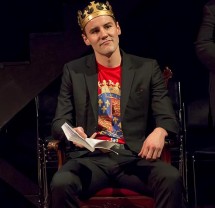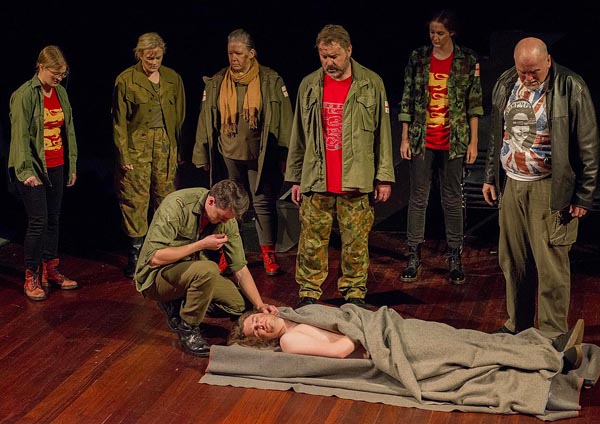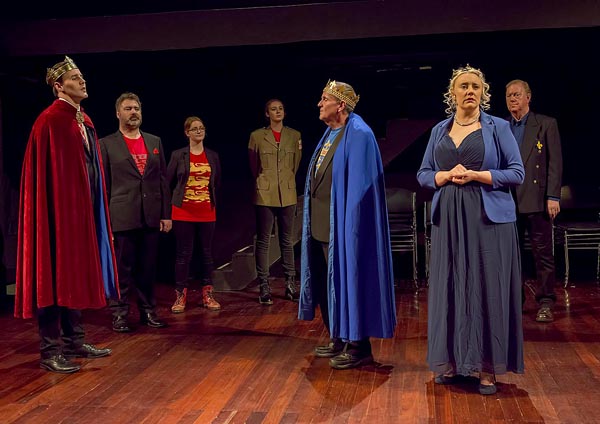Henry V (Bedlam Version)

Henry V (Adelaide University Theatre Guild, 6 May 2017) (Directed by Megan Dansie)
“Diagnostic criteria for Post Traumatic Stress Disorder include a history of exposure to a traumatic event that meets specific stipulations and symptoms from each of four symptom clusters: intrusion, avoidance, negative alterations in cognitions and mood, and alterations in arousal and reactivity.” (DSM-5).
This is some way from the Welsh soldier Fluellen’s reference to Henry V by analogy to Alexander the Great: “in his rages, and his furies, and his wraths, and his cholers, and his moods, and his displeasures, and his indignations…” Henry Five turfed his buddies like Henry Eight did his wives. Hazlitt in The Characters of Shakespeare’s Plays called Henry V “a very amiable monster, a very splendid pageant…”
In the famous films of the play by Olivier (1944) and Branagh (1989) the framed staginess is accentuated, most obviously in the form and declamations of the Chorus but also in the riveting war speeches by the Warrior-King, in particular, the grand defiance at Agincourt. Hence the conceit of soldiers addled by PTSD staging Henry V – usually in the wake one of the modern wars – has become a popular motif, done often in London and the U.S. And here we go again. The Director of this Guild production, which offered some but not enough good things, stated in the programme that she “wanted to avoid a traditional medieval setting, or a strictly authentic modern military one. Shakespeare is taught in prisons and in therapy groups in the USA and the UK. This led to the idea of our performance being by the participants in a PTSD therapy group, with the therapist as Chorus.”
Respectfully, this makes no sense, especially in a production that plays it straight, albeit inadequately. Apart from the odd flourish, the odd insinuation of damage in the cast, and a little touch of doctor in the night, there was precious little evidence of PTSD in any of the cast.

“Celle-là, ce n’est pas in baiser qui l’épeure!” The youthful lovers make their relationship a mere formality.
Nor did we particularly care. The plain truth of it is that the performance gained nothing from this revisionist trope, which it mostly ignored throughout.
Which leaves us with one of the Bard’s lesser history plays, a stirring bit of jingo designed to please the court, where the best character (Falstaff) doesn’t even show up, leaving the heavy lifting to Bill’s least interesting King.
The Varnished Culture had mixed reactions to Nick Duddy as Henry. L thought he carried on like a small boy served vanilla ice-cream instead of chocolate. P felt that was the quintessential royal Taff, and thought Duddy was fairly good in the role. Whilst he stumbled on the verse at times (and by the way, we are not at all sure the cast’s pronunciation of ‘Dauphin’ is the correct one), he was appropriately heroic and jaw-rippling, including in the famous peroration, “We few…we happy few…etc.’
Ellie McPhee, who had two roles during the evening, was fine as his bride to be, repeating the foreign word ‘Nails’ with relish. Steve Marvanek (Exeter), Rose Harvey (Gloucester), Lindsay Dunn (as the French King), Georgia Stockham (as the French Queen) and Tony Busch, in his role of Montjoy, all had the requisite gravitas.
 The Chorus (Peter Davis) was adequate but needs to deliver his links with more authority and volume.
The Chorus (Peter Davis) was adequate but needs to deliver his links with more authority and volume.
As we said, there were some good things. We liked the efficiency of scene changes, the heraldic and back lighting, and the enthusiasm of the cast (despite being dressed as rag-tag mercenaries) in the battle scenes, particularly the assault on Harfleur. The miners emerging from the stage trap was neatly done. Matt Houston, in a cabaret turn as Fluellen, was amusing and Dylan O’Donnell, as the incomprehensible Scots Captain Jamy, was hilarious.
But some of the performers were a tad overheated and the play was too long – it needs the excision of several scenes. Frankly, it would have been more satisfactory to end with the post-battle ‘hey nonny’ song – the subsequent comic, wooing, and reconciliation-of-nations scenes should have been discarded, the production having begun to pall well before.
Actually, it was something of a slog! Dare we accuse and convict its designers of on over-fondness for, an over reliance on, the script?
There has to be a more robust and objective approach than just ‘letting the verse do the work’ – particularly when on the aspect of the verse, love’s labour’s not only been lost, but mangled.
So, in the final analysis, this effort is worth a look and at times enjoyable, but ‘shall stand sore charged for the wasted remainder, its gayness and its gilt much besmirched’ (With apologies to W.S.) We hope some cuts and revamping of the piece occurs, towards an imminent remedy. And The Varnished Culture reminds the cast and crew that, as Tynan quoth George Nathan, “Art and the artist are ever youthful lovers: criticism is their chaperone.”
Leave a comment...
While your email address is required to post a comment, it will NOT be published.





3 Comments